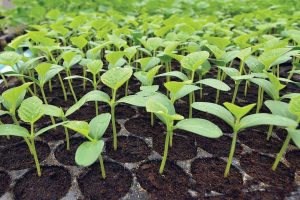Planting by the Moon and Stars
06 Jul 2019
Biodynamic farming harnesses the powers of the cosmos for a growing boost.
By Maggie Woodland Gardeners have to consider several factors when deciding on the best time to plant seeds—the type of crop, time of year, average daily temperature, likelihood of frost, and so on. Mikl Brawner of Harlequin’s Gardens in Boulder follows an even more extensive list of variables, which he integrates into his gardening schedule to great success. He recommends using moon phases, planetary movements and star constellations as indicators of beneficial planting times. “A lot of people think that’s very woo-woo,” he says, “but the fact is there’s a very obvious connection between the pull of the moon and its effect on the world, and the main mechanism is water. Plants are mostly water, so even though celestial bodies are far away, they have an influence.” The idea of planting crops in accordance with lunar movements is by no means new; Pliny the Elder wrote about it in his book, “Naturalis Historia,” published in A.D. 77-79, and many civilizations used lunar calendars far earlier than that. Modern champions of lunar-based agriculture include Austrian philosopher Rudolf Steiner, who encouraged his followers to plant crops two days before the full moon for optimal rooting. German farmer Maria Thun followed Steiner’s work, and in the 1950s she theorized that planting while the moon was moving in front of certain constellations could affect the success of different crops. She conducted experiments on her own farm in Darmstadt, Germany, to test her theory. After years of trials, Thun determined that root vegetables grew best if planted while the moon was passing through earth-sign zodiac phases; leafy crops thrived if planted when the moon was over water-sign constellations; flowering plants did best with air signs; and fruits benefitted from fire signs (all based on the sidereal zodiac). In 1962, Thun began producing calendars to share her insights with other farmers, and her studies expanded to include planetary movements as well. This work added substantial support to Steiner’s organic approach, known as biodynamic agriculture.More Than Luck
Brawner has followed Thun’s biodynamic almanac for decades, and although he hasn’t conducted any comparative tests, he’s had far more success than he would attribute to pure luck and skill. He says, “I was not an accomplished propagator when I started, but I grew plants for the nursery for 20 years and had great success. A lot of people see their plants die from damping off, and I didn’t have that problem.” In light of his good results with Thun’s methods, Brawner began teaching an annual class at Harlequin’s Gardens called “Planting by the Moon and Stars,” in which he guides fellow gardeners through the complex process of astrologically optimal planting, cultivating and harvesting. A seasoned teacher can be a huge help for people first dipping their toes into the complicated world of biodynamic gardening. Brawner teaches from the Stella Natura calendar, which is a North American adaptation of Thun’s almanac, edited by Sherry Wildfeuer and supplemented with charts and articles on biodynamic gardening. These help readers understand some of the more complex growing periods, such as perigee and apogee—the times when the moon is closest to and farthest from the Earth, respectively. Planting is not recommended during perigee because the moon’s strong gravitational pull can draw too much moisture up in the soil, leaving plants more susceptible to fungal diseases and rot. Plants sown during apogee may sprout a flower stalk more quickly, which is fine for flowers or fruit-bearing plants, but not ideal for root vegetables or leafy plants.












